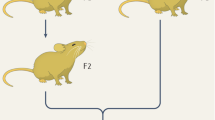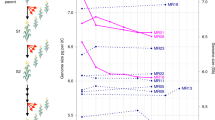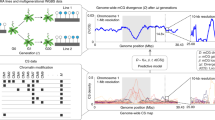Abstract
Arising from: S. J. Lolle, J. L. Victor, J. M. Young & R. E. Pruitt Nature 434, 505–509 (2005); see also communication from Chaudhury; Lolle et al. reply.
According to classical mendelian genetics, individuals homozygous for an allele always breed true. Lolle et al.1 report a pattern of non-mendelian inheritance in the hothead (hth) mutant of Arabidopsis thaliana, in which a plant homozygous at a particular locus upon self-crossing produces progeny that are 10% heterozygous; they claim that this is the result of the emerging allele having been reintroduced into the chromosome from a cache of RNA inherited from a previous generation. Here I suggest that these results are equally compatible with a gene conversion that occurred through the use as a template of DNA fragments that were inherited from a previous generation and propagated in archival form in the meristem cells that generate the plant germ lines. This alternative model is compatible with several important observations by Lolle et al.1.
Similar content being viewed by others
Main
Such archival forms of DNA have been described previously2. The template DNA could have originated in the fragmented genomes of three of the four haploid female meiotic products in the germline of a heterozygous plant. Within the ovule of the original heterozygous plant, the surviving haploid female germline cell containing the mutant hth allele acquires from the degenerating sister nuclei a collection of chromatin fragments that are presumably heterochromatinized and silenced; they might also be covalently modified and therefore hard to detect by Southern blotting or by amplification in the polymerase chain reaction.
I propose that these supernumerary chromatin fragments propagate within the meristem cells of succeeding generations, and so are present in a very few cells of the plant; nevertheless, they are often present in the germ lines that are themselves derived from the meristem. Within a second-generation descendant that is homozygous for a chromosomal allele, such supernumerary chromatin fragments might harbour another allele in a cryptic state. These supernumerary fragments might pair with normal chromosomes in the male germ line preferentially, as indicated by Lolle et al.1, where they direct gene conversion of the chromosomal alleles. The gene-converted allele, therefore, would reappear as a mendelian factor in the third or a subsequent generation.
This proposal dispenses with the hypothetical RNA cache1, for which little evidence exists. It is consistent with the incidence of supernumerary chromosome fragments in plants, particularly with their known effects on pollen function3, and explains the lack of somatic convertant sector in any generation1; it also invokes standard molecular processes of DNA-directed gene conversion over relatively long regions of homology. The differences in the frequency of conversion of the three tested alleles1 may reflect co-conversion polarity4.
My proposal can also explain the curiously high frequency of allele reappearance in dissected embryos, which is roughly twice that found in mature plants (it increased from 10% to 20%). Assume that gene conversion produces a heteroduplex DNA that escapes mismatch repair. If conversion occurs in the haploid generative nucleus of the pollen, the two sperm cells will be non-identical at the converted allele. After double fertilization, the embryo and the endosperm will contain two different alleles. An embryo dissected from such a seed will inevitably be associated with endosperm cells, and will yield a signal in the polymerase chain reaction that is indistinguishable from a heterozygous embryo, although the embryo itself is homozygous for the allele. As this will occur as often as a conversion, the frequency of the total converted allele in dissected embryos and endosperms together should be about 20%, an estimate close to the experimentally observed rate.
The model proposed here, but not one in which gene conversion is directed by RNA5 or by very short, dispersed, repeated DNA sequences6, is easily reconciled with the notion of co-conversion polarity4. It should be possible to test whether co-conversion polarity is a factor in the phenomenon revealed by Lolle et al.1 by producing double- and triple- mutant alleles through exploitation of this effect. Further investigations into the possibility and nature of DNA archiving in plants and of plant germ lines should prove interesting.
References
Lolle, S. J., Victor, J. L., Young, J. M. & Pruitt, R. E. Nature 434, 505–509 (2005).
Downs, D. M. & Roth, J. R. Genetics 117, 367–380 (1987).
Stebbins, G. L. in Chromosomal Evolution in Higher Plants 67–71 (Addison-Wesley, Reading, Massachusetts, 1971).
Nicolas, A. & Petes, T. D. Experientia 50, 242–262 (1994).
Baltimore, D. Cell 40, 481–482 (1985).
Chaudhury, A. Nature doi:10.1038/nature04062 (2005).
Author information
Authors and Affiliations
Corresponding author
Rights and permissions
This article is distributed under the terms of the Creative Commons Attribution-Non-Commercial-Share Alike licence (http://creativecommons.org/licenses/by-nc-sa/3.0/), which permits distribution, and reproduction in any medium, provided the original author and source are credited. This licence does not permit commercial exploitation, and derivative works must be licensed under the same or similar licence.
About this article
Cite this article
Ray, A. RNA cache or genome trash?. Nature 437, E1–E2 (2005). https://doi.org/10.1038/nature04063
Published:
Issue Date:
DOI: https://doi.org/10.1038/nature04063
This article is cited by
-
Hothead healer and extragenomic information
Nature (2005)
-
Hothead healer and extragenomic information (reply)
Nature (2005)
-
Media should campaign on the basis of facts
Nature (2005)
-
Media reports: call for a working party is unrealistic
Nature (2005)
-
Concern at animal research should not be dismissed
Nature (2005)
Comments
By submitting a comment you agree to abide by our Terms and Community Guidelines. If you find something abusive or that does not comply with our terms or guidelines please flag it as inappropriate.



